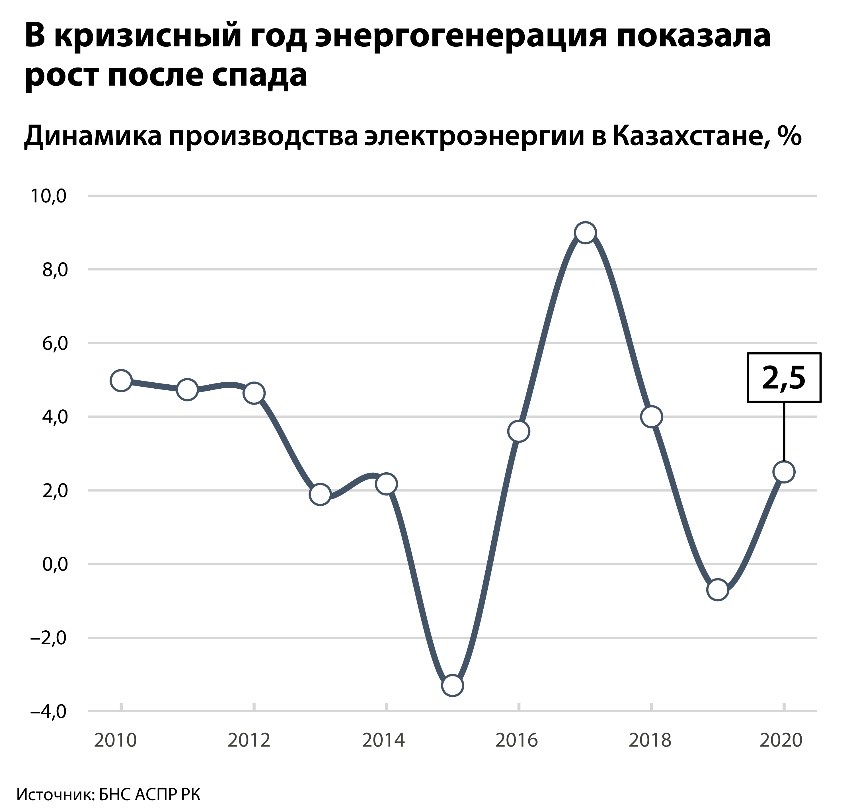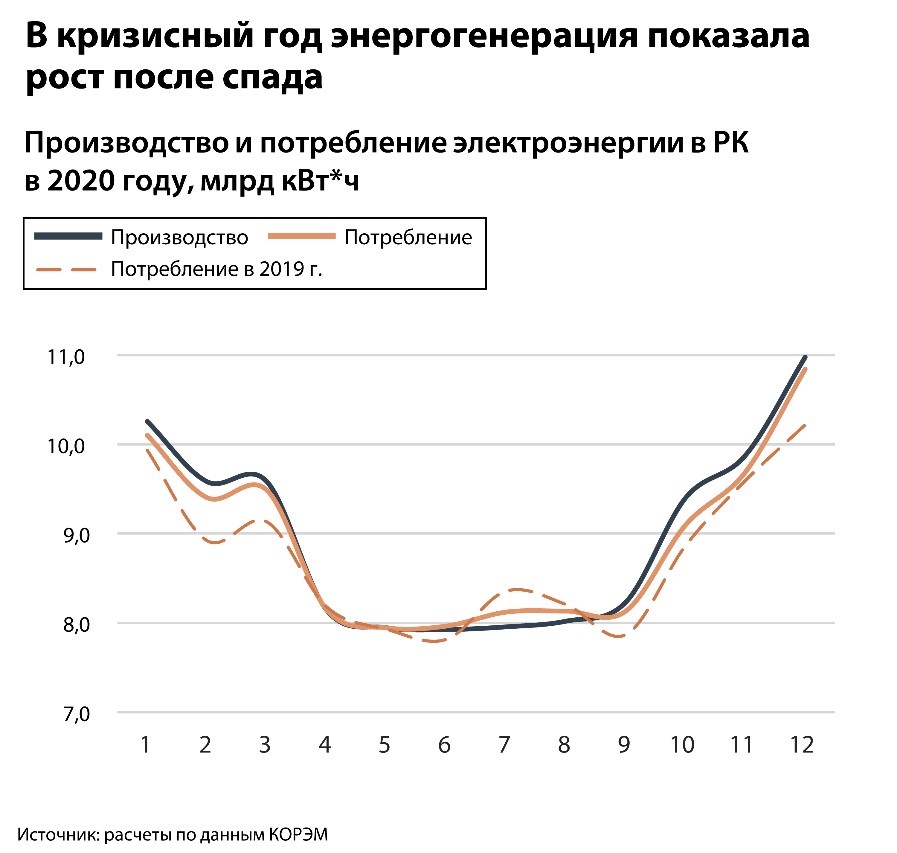Kazakhstan Electricity Market
Electricity production in Kazakhstan is carried out by 179 power plants of various forms of ownership. As of 01.01.2021, the total installed capacity of power plants in Kazakhstan was 23 621.6 MW, the available capacity was 20 078.6 MW.
According to the Bureau of National Statistics of the Republic of Kazakhstan, the growth in electricity generation in 2020 was 2.5%. The positive dynamics was caused by several factors: a decrease in consumption by energy retail companies led to increase in supplies to some industrial enterprises in the large cities; in addition, the power plants were bailed out by exports to the countries of Central Asia in the fall.

The standard reaction of the economy to the crisis is to reduce electricity consumption. If in 2015, against the backdrop of a recession in the economy, electricity production decreased by 3.3%, then in the year of 4.5% economic growth, generation fell by 0.7%. In 2020, when the GDP decreased by 2.6%, there was an increase in the electric power industry by 2.5%, up to 109.2 billion kWh (Office of National Statistics of the Republic of Kazakhstan). Analysis of KOREM’s operational information (monthly reports) also confirmed that electricity generation increased by 1.9% (107.9 billion kWh).
Thermal power plants still dominate in the structure of electricity production: their share is 88% (including gas turbine power plants), the share of hydroelectric power plants is 9%, and of renewable energy sources (RES) is 3%.
There were two stable trends: an increase in RES-generation, as well as a reduction in generation at hydroelectric power plants, while coal and gas thermal power plants continued to increase production: in 2020, thermal power plants generated by 0.4% more electricity than in the last year, and hydroelectric power plants – by 4.3% less.
Analysis of electricity production and consumption curves in 2020 and 2019 showed that quarantine restrictions had a slight impact on consumption in the spring, but were noticeable in the summer.
For the year as a whole, consumption remained below last year’s level, but in several months it was noticeably lower (July, August), and a decrease was noted in all three zones of the national energy system. Full recovery of consumption (exceeding last year’s indicators in all three zones) occurred in December.

The rating of the largest energy producing enterprises in Kazakhstan includes 14 organizations that stand out in the operational statistics of KOREM. In 2020, these 14 enterprises accounted for 65% of all electricity produced in the country, with the top 10 – 59%, and the top 5 – 48%. The generating segment of the Kazakhstani electric power industry has remained highly concentrated since the Soviet period; the degree of dependence on a number of energy sources is extremely high.
There were no changes in the rating of the largest energy-producing enterprises for the year. Like a year ago, the leader was Ekibastuz GRES-1 (an asset of the Samruk-Energo national company; 4000 MW installed capacity), its production volume in 2020 amounted to about 19.5 billion kWh, which was 6.4 % above the level of 2019. The last five years had been a period of restoration for the plant – several units were overhauled and the average growth rate of generation was 23.7%. The station provides electricity to the energy deficient zones of the country (South and West), and exports electricity.
Aksu GRES EEC (ERG energy asset; Eurasian group; installed capacity – 2,450 MW) was on the second place, its generation amounted to 14.0 billion kWh (1.8% increase). The station met the needs of the largest metallurgical plants of the Eurasian group – Aksu Ferroalloy Plant, Pavlodar Aluminum Plant and Kazakhstan Electrolysis Plant.
Ekibastuz GRES-2 (installed capacity – 1000 MW) with 5.0 billion kWh (0.9% increase) was on the third place. The fourth in the list was Topar GRES (former Karaganda GRES-2; installed capacity – 743 MW), controlled by the Kazakhmys corporation and designed to meet the needs of the mining and metallurgical enterprises of the corporation in the Karaganda region, reduced output by 1.6% (to 4.6 billion kWh).
The top five was closed by the Karaganda CHPP-3 (part of the Kazakhstan Utilities Systems; KKS; installed capacity – 670 MW), where, according to KOREM’s operational data, production decreased by 5.3%, to 4.2 billion kWh, but in a five-year retrospective the station increased production by an average of 4.6% per year.
Table 1. Rating of the largest power generating enterprises of Kazakhstan in 2020
| Place in 2019 (2020) | Energy generating company | Production volume in 2020, million kW*h | Changes to 2019 | Average dynamics in 2016-2020, % |
| 1 | Ekibastuz GRES – 1 | 19 465 | 6,4% | 23,7% |
| 2 | Aksu GRES | 14 020 | 1,8% | 0,4% |
| 3 | Ekibastuz GRES – 2 | 4 974 | 0,9% | 0,2% |
| 4 | GRES Topar LLP | 4 640 | – 1,6% | 1,7% |
| 5 | Karaganda CHPP-3 | 4 204 | – 5,3% | 4,6% |
| 6 | Almaty CHPP – 1, 2, 3 | 4 196 | 1,9% | – 0,4% |
| 7 | Pavlodar CHPP – 2, 3 | 3 636 | 4,2% | – 3,9% |
| 8 | Petropavlovsk CHPP – 2 | 3 304 | – 4,7% | – 5,6% |
| 9 | Bukhtarma hydropower complex | 2 940 | – 4,7% | – 2,0% |
| 10 | Pavlodar CHPP – 1 | 2 127 | 0,3% | – 6,0% |
| 11 | Zhambyl GRES | 1 809 | – 3,7% | – 6,1% |
| 12 | Shulbinsk GRES | 1 738 | – 3,6% | 0,9% |
| 13 | UST-Kamenogorsk GRES | 1 730 | – 2,6% | 1,4% |
| 14 | Moynak GRES | 926 | – 2,4% | – 4,7% |
| Others | 38 151 | 2,9% | 3,5% |
The five largest plants in 2020 increased their output by 2.5%, the dynamics of the top 10 energy producing enterprises was + 1.7%.
The share of RES in the energy balance of Kazakhstan in 2020 reached 3%, as it was planned in the concept for the transition to a green economy. According to the Ministry of Energy of the Republic of Kazakhstan, the total volume of RES-generation amounted to 3.2 billion kWh, having increased by more than a third compared to the previous year. The most dynamic growth was recorded in the segment of solar power plants (SPP), the generation increased by 140% over the year (up to 1,350 million kWh), and over five years – in 15 times. Production at wind power plants (WPPs) increased fourfold over the five-year period and at the end of 2020 amounted to 1,077 million kWh (+ 50% per year). Small hydropower plants produced 812 million kWh of electricity, which was 27% lower than the result in 2019, but almost one and a half time higher than the output in 2016.

In the first half of 2021, all power plants of the republic generated 57,325.4 million kWh, which was 7.1% more than in the same period in 2020. An increase in production was observed in all zones of the Unified Energy System (UES) of Kazakhstan.
At the same time, there was an increase by 6% in the dynamics of electricity consumption in the republic in January-June 2021compared to January-June 2020: consumption increased by 6% in the northern part of the country, by 10% in the southern part and by 2% in the part.
The volume of electricity production by facilities using RES (solar and wind power plants, small hydroelectric power plants, biogas plants) in Kazakhstan in January-June 2021 amounted to 2005.5 million kWh. The increase was 1.4% compared to the period of January-June 2020 (1,470 million kWh).
Sources: https://kursiv.kz/ and https://forbes.kz/

